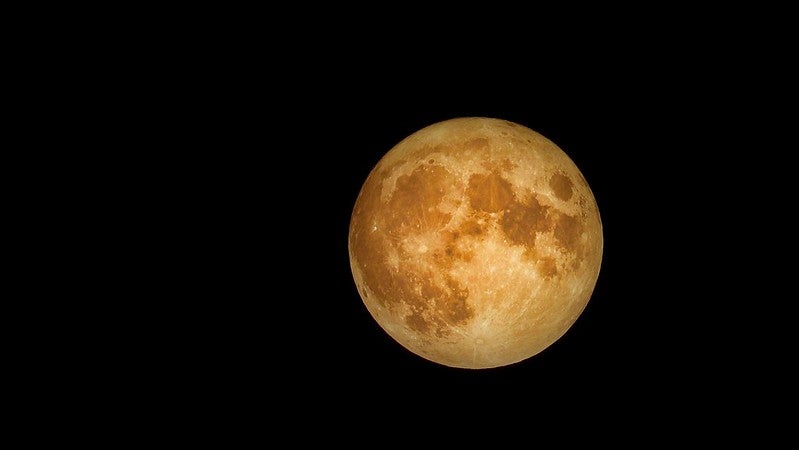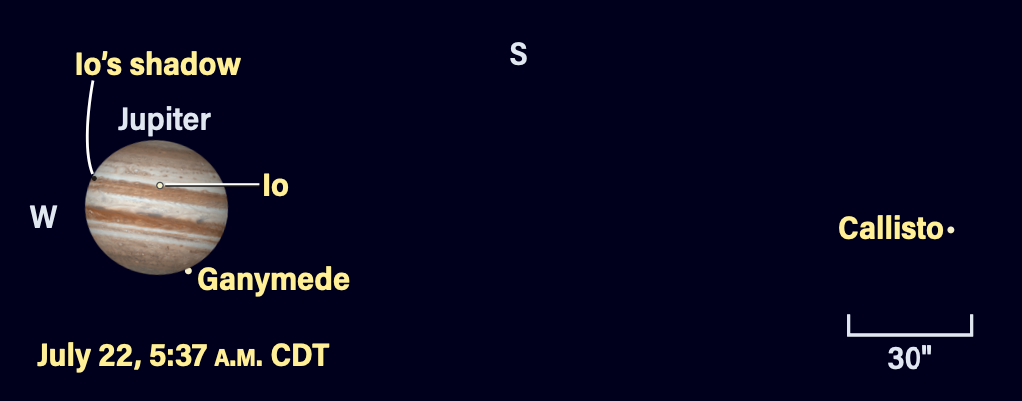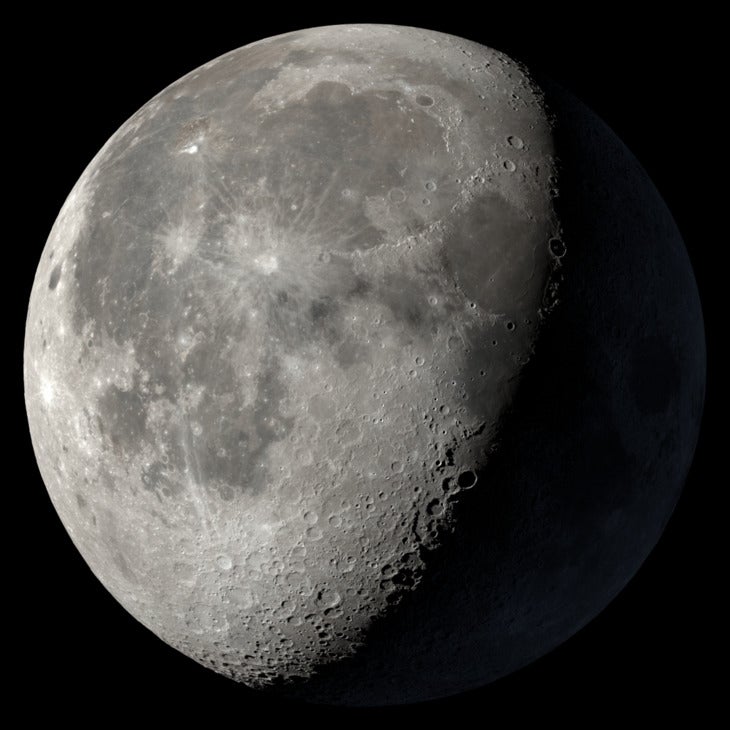
Friday, July 19
Taurus the Bull may be one of the premier winter constellations, but did you know there’s also a bull in the summer nighttime sky? Known as Taurus Poniatovii or Poniatowski’s Bull, this small constellation was created by Marcin Poczobut, director of Vilnius Observatory in Lithuania, in 1777. It is one of countless constellations no longer officially recognized following the approval of the 88 modern-day constellations by the International Astronomical Union in 1928.
Although no longer “official,” Poniatowski’s Bull nonetheless remains visible in the sky for those who know how to find it. After darkness falls following sunset, look south toward the large constellation Ophiuchus. Poniatowski’s Bull lies just east of 3rd-magnitude Cebalrai, Ophiuchus’ beta star. The constellation sports a V-shaped face much like winter’s Taurus, facing upward at this time with its eastern eye marked by 5th-magnitude 73 Ophiuchi and the watern eye by 4th-magnitude 66 Oph. The bull’s nose falls on 4th-magnitude 68 Oph. The V shape of its face extends farther upward, ending in two horns: 4-magnitude 72 Oph to the east and 6th-magnitude magnitude HD 163641 to the west.
Sunrise: 5:48 A.M.
Sunset: 8:25 P.M.
Moonrise: 7:37 P.M.
Moonset: 3:21 A.M.
Moon Phase: Waxing gibbous (96%)
*Times for sunrise, sunset, moonrise, and moonset are given in local time from 40° N 90° W. The Moon’s illumination is given at 12 P.M. local time from the same location.
Saturday, July 20
Tonight might be the night you spot dwarf planet 1 Ceres’ motion over the course of a single evening.
With a telescope, look south to find the Teapot of Sagittarius after sunset. Ceres is sliding through the Teapot’s body, near its base. Tonight Ceres is about 2.7° west of magnitude 2.6 Zeta (ζ) Sagittarii, which forms the lower join of handle and teapot. Ceres is also just 1° northwest of magnitude 7.6 M54, a compact globular cluster some 87,400 light-years away that belongs not to the Milky Way, but to one of the many dwarf galaxies orbiting it.
A little farther afield is another globular of similar brightness: magnitude 7.9 M70, about 3° southwest of M54 and 2.5° southwest of Ceres’ current position.
To notice Ceres’ movement from east to west, though, you’ll need to look closer, to where Ceres is moving away from a faint trapezoid of magnitude 8 to 10 stars. Ceres is closest to a magnitude 9.4 star that is not part of the trapezoid, but sits just north of its southwesternmost point. It will take several hours to spot the dwarf planet’s slight movement, but you might notice a tiny east-west shift.
Sunrise: 5:49 A.M.
Sunset: 8:24 P.M.
Moonrise: 8:27 P.M.
Moonset: 4:25 A.M.
Moon Phase: Waxing gibbous (99%)
Sunday, July 21
Ninth-magnitude asteroid 40 Harmonia is at opposition at 4 A.M. EDT today, rendering it visible all night from roughly dusk through dawn near the border of the constellations Sagittarius and Capricornus. Telescopic observers should be able to spot it just under 2° south of globular cluster M75, which glows at magnitude 8.5 from a distance of some 67,500 light-years from Earth.
However, the Full Moon — which occurs at 6:17 A.M. EDT this morning — is also visible from sunset to sunrise, not far from Harmonia’s location in Capricornus. The July Full Moon is often called the Buck Moon, as this is the time of year when male deer are growing their antlers. Our satellite’s bright light will make observing fainter Harmonia and M75 difficult, so you may do best to come back in a few nights, once the Moon has begun to wane and move on.
Instead, try your luck spotting some of the famous bright stars on the other side of the sky — turn west after sunset to see 1st-magnitude Spica in Virgo slowly setting within the Maiden. To Spica’s upper right is Arcturus, the magnitude –0.1 alpha star of Boötes the Herdsman. And to Arcturus’ right, you should be able to make out the bright stars that outline the Big Dipper: from handle to bowl, these are Alkaid, Mizar (and Alcor), Alioth, Megrez, Phecda, Merak, and Dubhe. Merak and Dubhe are also called the Pointer Stars, as they point along a line that ends at 2nd-magnitude Polaris, the North Star.
Sunrise: 5:49 A.M.
Sunset: 8:23 P.M.
Moonrise: 9:09 P.M.
Moonset: 5:39 A.M.
Moon Phase: Full

Monday, July 22
Mercury reaches its greatest eastern elongation from the Sun at 3 A.M. EDT, standing 27° east of our star at that time. Although it’s not visible then, you can try to catch the solar system’s smallest planet this evening after sunset, though you’ll need to be quick — it is just 5° high in the west 40 minutes after sunset and shines a dim magnitude 0.5. If you have binoculars, see if you can find magnitude 1.4 Regulus just above and slightly to the left of the planet, about 3° away.
Instead, early risers this morning will have a chance to check out a set of interesting events involving Jupiter’s Galilean moons Io and Ganymede.
Those in the eastern half of the U.S. will see a small shadow fall over Jupiter’s large disk starting around 4:31 A.M. EDT (note that Jupiter has only recently risen for those in the Midwest and stands about 10° high in the east, near Taurus’ bright red eye Aldebaran).
At the same time, the planet’s largest moon, Ganymede, is closing in on Jupiter’s northwestern limb. Ganymede disappears behind it around 4:38 A.M. EDT, though it may take several minutes for the huge moon to fully vanish from view.
Keep watching to see Io closing in from the east, chasing its shadow. Io finally begins its own transit around 5:31 A.M. EDT. And Ganymede, which has been traveling behind Jupiter this whole time, reappears from behind the northeastern limb around 4:36 A.M. MDT (note the time change), in bright twilight for the Midwest and after daybreak farther east.
Observers on the U.S. East Coast may snag a bonus: Check out Jupiter at 3 A.M. EDT, and you’ll note that Europa stands just west of Ganymede (also to Jupiter’s west). Keep watching, and some five to six minutes later you’ll notice Europa wink out of view. That’s because the small moon has passed into Jupiter’s long, dark shadow from our point of view, dimming it out of sight. Ganymede’s orbit, however, avoids the shadow, keeping the moon visible until it passes behind the planet’s limb an hour and a half later.
Sunrise: 5:50 A.M.
Sunset: 8:22 P.M.
Moonrise: 9:44 P.M.
Moonset: 6:56 A.M.
Moon Phase: Waning gibbous (98%)
Tuesday, July 23
Pluto reaches opposition in Capricornus the Sea Goat at 2 A.M. EDT. However, the distant dwarf planet is largely out of reach for the average amateur — only observers with scopes 11 inches or larger will be able to spot it. And even then, it will be challenging.
If you have the right equipment and want to give it a go, you can find the magnitude 14.4 world in southwestern Capricornus, near Harmonia’s location in far eastern Sagittarius (see the entry a few days ago, when Harmonia reached opposition). The brightest nearby signpost to Pluto might be M75; the globular cluster lies just over 2° northwest of Pluto’s position. Most go-to scopes should be able to take your view right to Pluto, which lies about 20′ from the 10th-magnitude field star HD 192155.
Note, however, that the bright gibbous Moon is still nearby, albeit now in central Aquarius. So even if you have access to a larger instrument, you might do better to wait a few more nights, when the Moon will both have moved farther away and is rising later in the night, giving you more darkness to try to search out the faint, distant world.
If you want an easier target for tonight, gaze overhead around local midnight to find the cross-shaped constellation Cygnus. At the top of the cross — also the tail of the swan that Cygnus is meant to represent — is Deneb. At the base, the swan’s head, is Albireo. This 3rd-magnitude star is a gorgeous double that is easy to split in any scope, comprising two stars some 34″ apart. One is a stunning sapphire blue, while the other is a deep orange. Their contrasting colors arise from their different temperatures — the bluer star is much hotter than its more orangey counterpart.
Sunrise: 5:51 A.M.
Sunset: 8:21 P.M.
Moonrise: 10:12 P.M.
Moonset: 8:14 A.M.
Moon Phase: Waning gibbous (93%)
Wednesday, July 24
The Moon reaches perigee, the closest point to Earth in its orbit, at 1:41 A.M. EDT. At that time, our satellite will sit 226,749 miles (364,917 kilometers) away.
The Moon also passes 0.4° north of Saturn at 5 P.M. EDT; observers in southeast Asia will see our satellite completely cover the planet in an occultation — you can check out whether the event is visible from your location on the International Occultation Timing Association’s webpage for the event here.
Other observers can catch the lovely pairing in the sky overnight. Saturn rises around 10:30 P.M. local daylight time, with the Moon following roughly 10 minutes later in eastern Aquarius. Saturn, glowing at magnitude 0.8, is now some 5° west of the 19-day-old Moon. Although both are not visible in the same telescopic field of view, binoculars should capture them together, and both are of course easy naked-eye objects.
You can use a telescope to zoom in on Saturn, whose disk currently spans 18″ and rings stretch about 41″ along the long axis. You may even spot its brightest moon, 8th-magnitude Titan, about 1′ east of the planet tonight. The 10th-magnitude moons Tethys and Rhea lie closer to the rings, one on either side (Tethys to the east, Rhea to the west), but they may be difficult to spot with the nearby Moon throwing its light through the sky.
Even harder to track — but worth it for those with large scopes and video-capture capabilities — is a triple transit as Mimas, Enceladus, and Rhea traverse the disk. Around midnight EDT, all three are visible on the disk south of the rings, with Rhea in the lead farthest west, followed by Enceladus and then Mimas farthest east. Falling on the cloud tops are the shadows of Enceladus and Mimas as well, leading their respective moons; Rhea’s shadow has already disappeared from the disk, though if you’re recording about 10 to 20 minutes prior, you may capture it approaching the southwestern limb.
Sunrise: 5:52 A.M.
Sunset: 8:21 P.M.
Moonrise: 10:38 P.M.
Moonset: 9:31 A.M.
Moon Phase: Waning gibbous (86%)

Thursday, July 25
The Moon now passes 0.6° north of Neptune at 11 A.M. EDT. The planet rises around 11 P.M. local daylight time, below the Circlet asterism in Pisces. The Moon now lies in far northwestern Cetus, some 8.5° east of the ice giant.
Luna is now some 72 percent lit, with the eastern Sea of Serenity falling into shadow as the two-week-long lunar night starts to creep across the nearside. Still visible west of the day-night dividing line, the terminator, in the lunar south is the bright, rayed crater Tycho, which spans some 53 miles (84 km) in diameter. Just north of the lunar equator, you’ll find another large, rayed crater: Copernicus, which spans roughly 58 miles (93 km).
Let’s turn back to Neptune, which requires optical aid to spot, as its distance renders it a faint magnitude 7.7. Binoculars or any scope should show it as a small, “flat,” bluish star. Neptune is now 2.7 billion miles (4.39 billion km) from Earth, so even though it is a large ice giant, it appears just 2″ across in our sky. It is currently 5.5° southeast of magnitude 4.5 Lambda (λ) Piscium, the southeasternmost star in the Circlet.
Sunrise: 5:53 A.M.
Sunset: 8:20 P.M.
Moonrise: 11:02 P.M.
Moonset: 10:45 A.M.
Moon Phase: Waning gibbous (77%)
Friday, July 26
Some 30° high in the east an hour before sunrise, the constellation Taurus hosts not one, not two, but three planets within its borders. The easiest to spot is Jupiter, shining at magnitude –2.1 — brighter than any of the constellation’s stars. The solar system’s largest planet lies 5.8° to the upper right (north) of Taurus’ alpha star, Aldebaran, a bright red giant that shines at magnitude 0.9.
About 8° above (northwest of) Aldebaran, magnitude 0.9 Mars matches the star for brightness — and possibly even color, as the Red Planet’s rusty surface reflects sunlight back to us. Although much closer to Earth than Jupiter, Mars is smaller than our planet (and much smaller than Jupiter); compare its 6″ width to Jupiter’s whopping 35″ through a telescope!
Finally, swing your gaze up toward the Pleiades, cataloged by Charles Messier as entry No. 45 in his list of non-comets. About 5.7° south-southwest of this sparkling star cluster lies Uranus, the second-farthest planet from the Sun. Glowing a faint magnitude 5.8, you’ll need binoculars or a telescope to view its 4″-wide, grayish disk.
Uranus and Mars sat close in a conjunction nearly two weeks ago, when they were a mere 0.6° apart on the 15th. Now, the planets are just over 7° apart, as nearby Mars has pulled rapidly away, leaving Uranus behind as it moves only slowly through our sky, thanks to its greater. distance.
Sunrise: 5:54 A.M.
Sunset: 8:19 P.M.
Moonrise: 11:27 P.M.
Moonset: 11:59 A.M.
Moon Phase: Waning gibbous (66%)

Sky This Week is brought to you in part by Celestron.

